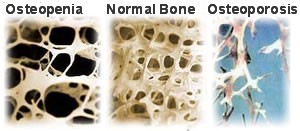 Bone gradually becomes brittle, porous and prone to fractures. In most cases osteopenia is a natural part of the aging process. Most women with osteopenia will not develop osteoporosis, although it does raise their risk factors. |
OsteopeniaContents • What Is Osteopenia? |
| What Is Osteopenia?
If you have osteopenia it means that your bones are becoming thin and brittle, but not brittle enough to be classified as osteoporosis. Technically, osteopenia means you have lower than normal bone mineral density (BMD). It is considered by some as a potential precursor to osteoporosis. Millions of women worldwide have been diagnosed with osteopenia and many are taking drugs to inhibit further bone loss. But, as these drugs have risks and their benefits are questionable, many health experts are now questioning if the diagnosis of osteopenia may be doing more harm than good. Osteopenia produces no obvious signs or symptoms. You are unlikely to experience pain as a result of bones become thinner and more brittle. However, there is an increased risk of bone fractures the more brittle your bones become.
As we age, bones naturally become thinner. Existing bone cells are reabsorbed into the body faster than new ones can be made. As this happens the bone loses heaviness (density) and minerals, making them weaker, porous and prone to breaking and fracturing. All women start to naturally lose BMD after the age of 30. After the age of 40 we lose 1 to 5 percent of our BMD every year (the rate is only 1 percent in men). Hormones are a contributory factor for women. The sudden drop in estrogen (which is instrumental in building healthy bone tissue) around menopause contributes towards osteopenia (and in some eventually osteoporosis) by preventing the absorption of calcium and phosphates - both essential bone making ingredients. Other causes can also contribute to more rapid bone loss than normal:
Does Everyone With Osteopenia Develop Osteoporosis? No. If you receive a diagnosis of osteopenia, it simply means that your BMD is below the statistical norm for your age. Osteopenia is not considered a disease, whereas osteoporosis is. Osteopenia is a risk factor for osteoporosis (increases your chance of getting it), but it does not mean you will automatically develop it. According to some experts, the way we define osteopenia is too broad and crude - most women with osteopenia will not develop fragility fractures (one of the main symptoms of osteoporosis). It simply raises their risk. Osteopenia is diagnosed by a bone mineral density (BMD) test. This test (usually done with a DEXA scan) is done to check for signs of osteoporosis. See diagnosis of osteoporosis for more details of this test. To qualify as osteopenic, your T-score must be lower than minus 1 (lower than minus 2.5 is osteoporosis). That means your bone density is one standard deviation below that of an average 30 year old - your bone density statistically just falls outside of the normal range. The main problem with this argument is that the definition of what is normal bone mass is contentious. The World Health Organization (WHO) defines it as that of an average 30 year old woman. But because bone naturally deteriorates with age, anyone much older than 30 by definition will be diagnosed with osteopenia. It's rather like saying a 50 year old has skin disease because she has wrinkles. The WHO said that its definition of osteopenia was never meant as a tool for diagnosis or prescribing drugs. Yet that is what is happening. Many doctors prescribe osteoporosis drugs to women diagnosed with osteopenia based on the WHO criteria (although some still take a more conservative approach and adopt a wait and see policy). The treatment for osteopenia is highly controversial. FRAX guidelines indicate medication should be prescribed when your risk of hip fracture is 3 percent or more, or your general risk factor is 20 percent or more. Professor of medicine at the University of California says while bone loss drugs work if you have osteoporosis, "some studies suggest there is little benefit, if any benefit at all, if you take these drugs when you have osteopenia." For more on these medicines see, osteoporosis treatment. Outside of drugs, lifestyle changes including diet and exercise can help reduce bone loss and may prevent osteopenia turning into osteoporosis. For more see osteoporosis prevention.
|
Related Articles on Osteoporosis For more information, see the following: • Bone and joint problems: A to Z of symptoms and diseases. Back To Homepage: Womens Health Advice |
|
WOMENS HEALTH ADVICE: ABOUT OSTEOPOROSIS |